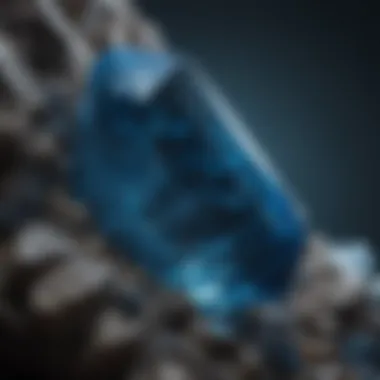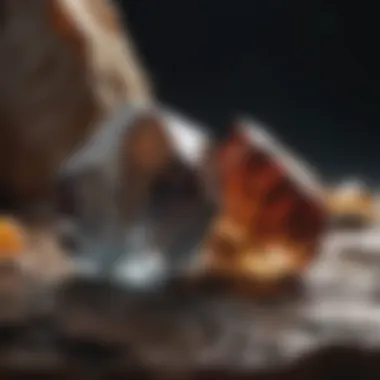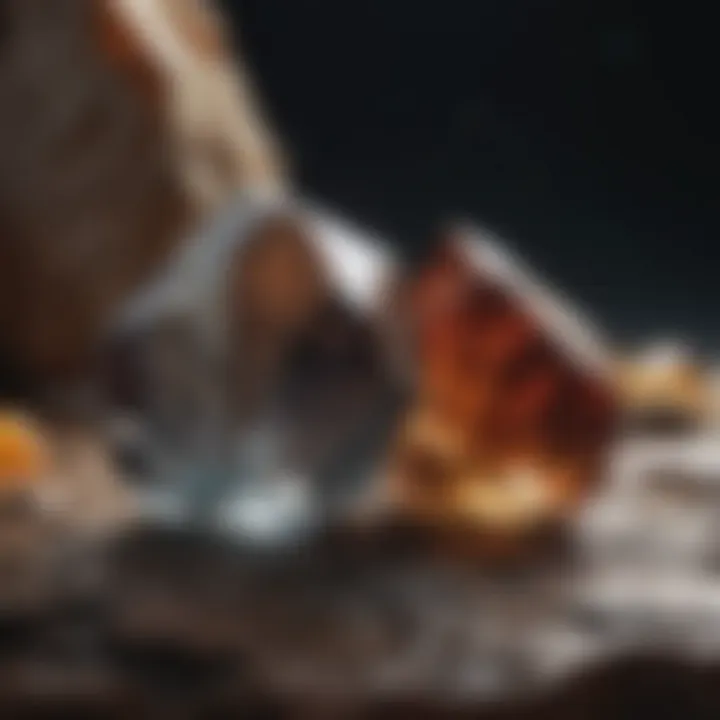Identifying Crystals by Color: A Detailed Overview


Intro
The allure of crystals is undeniable. Their beauty, steeped in history and cultural significance, resonates with many people. Understanding crystals through their color has become a key aspect for collectors and enthusiasts alike. Recognizing how the hues can guide identification not only enhances appreciation but also informs the value each piece may hold. Exploring the spectrum of options, a good eye for color can make all the difference.
History and Origins
Crystals have been a part of our human story for centuries. Ancient civilizations valued them not just for their beauty, but for their believed metaphysical properties. Take quartz, for example. The Greeks thought it was eternal ice. Cultures around the world have attributed significance to specific colors, claiming they held varying powers and protections.
Overview of Collectibles, Rocks, and Fossils
Crystals, rocks, and fossils form an essential part of the natural world. Their appeal lies in their unique story. Each piece is a fragment of time, a witness to geological events that shaped the Earth. Collecting these treasures can not only be fulfilling but also educational. Different types of rocks metamorphose and form in a variety of environments, leading to an array of colors and characteristics.
"Every crystal tells a story, etched in stone and shimmering with color."
Historical Significance and Cultural Impact
In the realms of art and medicine, the color of a crystal has often dictated its use and desirability. For instance, vibrant colors like deep azure blue lapis lazuli were once worth more than gold, revered not just for aesthetics but for mystique it carried. The significance of these colors often crossed geographical borders, influencing interactions and trade across cultures.
Identification and Classification
The process of identifying crystals based on color can feel overwhelming at times. Yet, comprehending the fundamentals can simplify your approach. Many enthusiasts start by familiarizing themselves with various species and the common colors associated with them.
Guide to Identifying Rocks and Fossils
Start with the visible features: color is the most immediate identifier. But it's important to consider the specifics—type of luster, any banding, veining, or translucency can all help narrow down possibilities. Furthermore, it's advisable to use good lighting while examining.
- Color: Bold, pastel, or even muted tones can indicate certain mineral compositions.
- Luster: Is it glassy, dull, or metallic?
- Translucency: Light play can reveal much about internal structures.
Common Types and Variations
Several common types of crystals can be identified primarily through their color. For instance:
- Amethyst: Recognized for its purple hue.
- Citrine: This yellow or orange variety captivates with its warmth.
- Rose Quartz: Soft pink, often linked with love and tranquility.
Variations do exist within each crystal type; these subtle changes can hinge upon impurities and geological differences. Understanding these nuances builds a more rounded appreciation of your collected specimens, linking the aesthetics of color beautifully with their scientific classifications.
Preamble to Crystal Identification
Identifying crystals by their color is more than just a visual exercise; it's an invitation into a world rich with meaning and complexity. This section sets the foundation for understanding just how crucial color is in determining crystal identity. With the vibrant palette that Mother Nature has to offer, each shade or hue can unveil layers of additional facets that may not be immediately visible at first glance.
Understanding crystals means appreciating their history, composition, and the environments from which they originate. Each crystal carries with it tales of geological processes that can span millions of years. For collectors and enthusiasts alike, recognizing these elements elevates the experience. Crystals are not merely decorative pieces, but storied artifacts that beg to be explored.
Understanding Crystals and Their Properties
Crystals are not simply minerals shaped into attractive forms; they possess properties that can inform us about their origin and formation. The internal arrangement of atoms within a crystal determines its hardness, cleavage, and, importantly, its color. Geology plays a significant role here: elements within the earth's crust, subjected to pressure and heat over time, forge crystals of various shapes and colors.
The color of a crystal can convey a myriad of information. For example, the presence of iron in quartz can result in beautiful shades of purple, as seen in amethyst, while a high level of chromium can create the lush green of emeralds. Understanding these properties enriches the identification process and assists collectors in discerning between similar-looking specimens.
The Role of Color in Identification
Color serves as a primary identifier for many crystals. It can instantly distinguish one gemstone from another in many cases. Yet relying solely on color can be deceptive. Two different minerals might share similar colors, but their internal structures may differ vastly.
For crystal enthusiasts, color adds an emotional and aesthetic aspect to the identification process. Different colors are often associated with various mystical or healing properties, giving each crystal its unique charm.
"The beauty of crystals is not just in their appearance but also in the stories they tell through their hues."
In practical terms, color aids in classification. It forms the crux of many databases and guides available for collectors. Understanding the nuances of color—how lighting affects perception, how impurities alter shades—allows for more accurate identification. As we proceed through this guide, keep in mind that color can be as telling as a crystal's physical form.
This knowledge sets the stage for the subsequent sections, where we dive into the science of colors in crystals, exploring their mineralogical roots and the environmental influences that shape them.
The Science Behind Crystal Colors
Understanding the science that underpins the colors of crystals is vital for collectors and enthusiasts alike. It serves as the bedrock for accurately identifying various types of crystals and understanding their unique properties. When you see a vibrant hue in a piece of quartz or a lustrous shade in a garnet, it’s not merely a question of aesthetics; it’s a result of mineralogical composition and environmental influences. The connection between color, chemistry, and external factors outlines not just how we classify these beauties, but also how we appreciate their significance in nature and in our collections.
Mineralogical Composition and Color
Crystals are defined by their specific arrangements of atoms, which determine their physical attributes, including color. For instance, the presence of different trace elements can dramatically alter the appearance of a crystal. Consider how the inclusion of iron can lend a deep red tone to a particular quartz variant, transforming it into the stunning carnelian.
- Examples of Mineral Influences on Color:


- Amethyst: Contains iron impurities that give rise to its purple tint.
- Aquamarine: The presence of iron results in gentle blue hues.
The key takeaway here is that the mineralogical framework of a crystal directly influences its coloration. This systematic approach enables collectors to identify and categorize various crystals confidently. Notably, slight variations in the composition can create a myriad of color shades, making the classification process not only intricate but also highly rewarding for those who enjoy digging deeper into the science.
Environmental Factors Influencing Color
While mineral composition is critical, the environment in which the crystal forms plays a significant role as well. Temperature, pressure, and the surrounding elements can change how a crystal develops its color.
For example, crystals formed in high-temperature environments may exhibit more vibrant colors compared to those formed in cooler settings. Additionally, exposure to radiation or specific gases can alter a crystal's color during its formation.
- Factors to Consider:
- Heat: Higher temperatures can enhance or dull certain colors during growth.
- Light: Different lighting conditions can affect how color is perceived, altering the appearance of the crystal in various settings.
Despite being well-known, these influences can often be underappreciated. Understanding these factors allows collectors not just to identify crystals by their color but also to appreciate the complex interplay between geological and chemical conditions that contribute to a crystal's unique appearance.
"The art of crystal identification is deeply rooted in an understanding of both the makeup and the environmental tale that each piece tells."
Methods of Identifying Crystals by Color
In the realm of crystal identification, understanding the methods used to discern color variations is pivotal. Identifying crystals by their color is not merely an aesthetic endeavor; it's a blend of science and art that provides a gateway into understanding a crystal's origins, properties, and potential usages. Each method has its own nuances, advantages, and considerations that can greatly enhance one’s collection capabilities.
Visual Inspection Techniques
The first and most direct method for identifying crystals by color is visual inspection. This technique relies on the human eye to differentiate slight shades and tones, which can often reveal distinguishing characteristics of the crystal. When conducting a visual inspection, lighting plays a crucial role. Natural light tends to provide the best clarity, as it showcases the crystal’s colors without the distortion that can come from artificial lighting.
Consider the following techniques during visual inspection:
- Direct Observation: Hold the crystal against various backgrounds. A black or white backdrop can enhance color visibility, revealing hues that may remain unnoticed otherwise.
- Light Angling: Rolling the crystal in your hand under the light can uncover different facets of its coloration.
- Surface Examination: Look closely at the surface for any zoning, color striations, or internal inclusions that may add to the color complexity.
"Color can be a compass, guiding collectors toward understanding a crystal's identity. Each shade tells a story."
Tools and Resources for Color Analysis
While naked eye inspection is invaluable, enhancing your analysis with tools can yield more precise results. A few notable instruments include:
- Spectrometers: These devices analyze the light absorbed and emitted by the crystal, allowing for a detailed assessment of its color properties.
- Color Comparison Charts: Utilized for side-by-side comparisons of crystals, these charts can help in matching shades accurately.
- Photography: Taking high-resolution photographs in varied lighting can serve as a reference, allowing you to document minute color differences.
Resources on color identification are abundant. For further exploration, websites such as Britannica and Reddit have forums and articles discussing specific techniques and experiences of other collectors.
Documentation and Color Comparison
Once you've identified the crystal’s color, it’s prudent to document your findings. Keeping a detailed record not only solidifies your knowledge but aids in future identifications. Consider the following documentation tips:
- Create a Color Log: Maintain a small notebook or digital file with photos, notes about colors, and characteristics that stood out to you during inspection.
- Compare Regularly: Revisit your past specimens to refine your understanding of color variations, as familiarity can lead to enhanced identification skills.
- Join Community Discussions: Engage with groups or social media platforms such as Facebook where enthusiasts share their insights about crystal colors.
By utilizing these methods of identification, collectors can sharpen their skills and deepen their appreciation for the diverse world of crystals while building a unique and informed collection.
Common Color Variations in Crystals
Understanding color variations in crystals is crucial for both seasoned collectors and novices. Often, the hue can indicate not only the type of crystal but also its quality and origin. Diverse colors arise from a myriad of factors, such as mineral composition, growth conditions, and environmental influences. Grasping these variations allows collectors to make more informed decisions when adding to their collections.
Transparent and Translucent Crystals
Transparent crystals allow light to pass through with little to no distortion, whereas translucent ones scatter light, creating a hazy effect. For instance, quartz is known for its transparency, boasting myriad colors from clear to smoky gray. Meanwhile, rose quartz is a translucent variant displaying a soft pink hue.
Both types offer unique charms and benefits. Collectors often cherish transparent crystals for their clarity and brilliance, making them suitable for jewelry and aesthetic display. Conversely, translucent crystals can imbue a sense of mystery and allure, enriching the visual appeal of any collection.
A few examples include:
- Amethyst: A transparent to translucent violet quartz.
- Citrine: Often transparent, providing a golden-yellow appearance renowned in both esoteric and decorative applications.
In terms of identification, transparent crystals might be assessed through light and clarity, while the color intensity in translucent ones can guide collectors on marketplace values.
Opaque Crystals and Their Unique Colors
Opaque crystals present a very different story. They do not transmit light, resulting in their solid colors that catch the eye in striking ways. Take malachite, for example. Its rich, green swirls are simply captivating, showing off intricate banding without revealing what lies within.
The beauty of opaque crystals lies in their bold statements. They often boast vibrant hues that can be associated with certain meanings or symbolism in various cultures. For collectors, understanding these colors is vital.


Key opaque crystals include:
- Obsidian: Usually black but can be found in hues of brown, including shimmering properties.
- Turquoise: An opaque blue-green that speaks to tranquility and protection.
Due to their unique appearances, collectors often pursue these crystals for their aesthetic value as much as for their geological interest.
Iridescence and Color Play in Crystals
Iridescence occurs when a crystal exhibits a shift in color when viewed from different angles. This feature, often seen in minerals like labradorite, can dramatically enhance a crystal's appeal. The play of color can evoke emotions and captivate the observer, sometimes drawing collectors back time and again.
Other examples of such crystals include:
- Moonstone: Regularly showcasing a blue sheen, which dances as light hits it, these stones can seem otherworldly.
- Opal: Famous for its multitude of colors that swirl within, opals can reflect nearly every color spectrum of light.
Understanding iridescence enhances crystal appreciation, adding another layer to identification. Collectors should consider both the color shifts and their implications in stories told by these crystals.
"Color is the keyboard, the eyes are the harmonies, the soul is the piano with many strings."
The appeal of color variations in crystals is an endless journey. Each hue and quality invites curiosity and appreciation, providing nuance that enhances both collecting and identification experience.
Case Studies of Color Identification
Understanding the various colors of crystals goes beyond just aesthetics; it’s about unraveling their identities, origins, and potential uses. This section delves into case studies that focus on color as a key identifier, providing insights into both common and rare crystals. Through such examples, collectors and enthusiasts alike can appreciate the nuance of color in crystal forms and learn how it helps in establishing authenticity, value, and performance in healing or decorative applications.
Popular Crystals and Their Colors
When discussing popular crystals, it's essential to recognize the role color plays in their identification. Well-known crystals like Amethyst, Rose Quartz, and Citrine exhibit distinct colors that are often the first identifiers for collectors.
- Amethyst: A stunning purple quartz that ranges from light lavender to deep violet. Its color is attributed to iron impurities and gamma radiation. Collectors often seek out the deeper shades, as they are believed to indicate higher quality.
- Rose Quartz: This lovely pink stone’s gentle hue comes from trace amounts of titanium, iron, or manganese. Notably associated with love and emotional healing, its soft color makes it a favorite among crystal enthusiasts.
- Citrine: The warm golden-yellow of Citrine comes from iron impurities, and it can range from pale to deep shades. This stone is often mistaken for its more precious counterpart, the yellow sapphire, thanks to its vibrant hue.
By analyzing these examples, enthusiasts learn to identify these crystals with relative ease, grounding their understanding in color. The significance of shades and tones not only helps underscore their identification but also hints at the properties they might hold.
Rare Varieties and Unique Color Profiles
Exploring the realm of rare varieties brings forth crystals that often flaunt striking and unusual color profiles. Such stones not only elevate collection value but also intrigue due to their distinctive characteristics.
- Black Opal: Known for its captivating play-of-color, the darker body tone of Black Opal can display flashes of red, green, and blue. This remarkable diversity of color means that every piece can be unique; each gem tells its own story through shades and patterns.
- Alexandrite: With its unique ability to change color from green in daylight to red under incandescent light, Alexandrite is a true curiosity of nature. This phenomenon is due to the presence of chromium, making it highly coveted among collectors and jewelers alike.
- Tanzanite: A striking blue-violet gem, Tanzanite’s color is fascinating because its hues can shift based on angle and light. This range makes every viewing experience genuinely different, enhancing its allure among collectors.
"From common to rare, the colors of crystals illuminate their identity and value, leading enthusiasts down paths of discovery."
In these case studies, it becomes evident that color is not just a visual trait—it is a narrative thread connecting the crystalline world to its collectors. It prompts exploration and appreciation of the diverse beauty nature offers. Identifying crystals through their color profiles not only enhances a collector's skills but also enriches their understanding of geology and mineralogy.
Common Misconceptions About Crystal Colors
Understanding the common misconceptions surrounding crystal colors is paramount for anyone diving deep into the world of crystal identification. Many people lump together the ideas of color, value, and even supposed mystical properties without considering the complexities involved. Misunderstanding these can lead to pitfalls, particularly for novice collectors who may not yet have the experience that comes with time and study.
For instance, it's often believed that brighter colors automatically indicate higher value. While certain gemstones like sapphires or rubies do command higher prices due to their vibrant hues, this is not a universal rule across all crystal types. In fact, the same color in different minerals can indicate distinct properties—this is where the nuances of mineralogy come into play.
Furthermore, a person's initial perception of color can be skewed by lighting, and improper methods in identification can result in an incorrect assessment of the crystal's worth. This is why educating oneself about the specific variations and their origins, along with a practical approach to color analysis, is crucial for informed crystal collecting.
Myths About Color and Value
A prevalent myth is the belief that all crystals with intense colors are valuable. This oversimplification can mislead many. For example, consider amethyst, which can come in shades ranging from light lavender to deep purple. While the deeper color may be more sought after, not everyone's attracted to that hue. Certain collectors may prefer the lighter variants for their aesthetic appeal or unique qualities that differ from the more common darker stones.
Additionally, some might believe that color intensity directly correlates to a crystal’s metaphysical properties, causing collectors to overlook other identifying features. In reality, crystals like aquamarine exhibit various shades, all of which hold unique qualities. The following points summarize a few critical aspects that clarify this misconception:
- Color does not equal rarity: Just because a color is appealing does not mean the crystal is rare. Rock and fossil collectors should focus on the crystal type rather than solely on hue.
- Market demand varies: Trends fluctuate, so what's valuable today may not be tomorrow. Always consider the broader market and specific collector preferences.
- Color can mislead authenticity: Enhanced stones may look vibrant, but that doesn’t guarantee their authenticity or origin. A thorough inspection often reveals much more.
The Impact of Color on Healing Properties
While many enthusiasts ascribe specific healing properties to certain colors, the reality isn't quite so straightforward. Some believe that if a crystal is blue, it promotes calmness, while red crystals boost energy. This notion, while it can be fascinating, lacks scientific bases. The connection between color and function is predominantly anecdotal and varies from person to person.
"Colors can evoke emotions, but when dealing with healing, one must look beyond just the visual spectrum."
For instance, the calming effect of blue lapis lazuli could be tied more to individual experiences or cultural beliefs than to an inherent property within the stone itself. Here are some thoughts to consider:
- Cultural influences: Different cultures may associate various colors with distinct emotions or healing attributes.
- Personal connections: Individual stories can tie a particular experience to a color, affecting how one perceives the healing properties of that crystal.
- Contextual use: The environment or the method with which one engages with the crystal may shape its perceived effectiveness.
Ethical Considerations in Crystal Collecting


When it comes to collecting crystals, there's much more at stake than just finding pretty rocks. Ethics in crystal collecting is a vital conversation that needs to happen more often in the community of enthusiasts and collectors. With an ever-increasing demand for crystals, and the subsequent pressure on sourcing them, understanding the significance of ethical practices becomes crucial.
Sustainability in Sourcing Crystals
Sustainability isn't just a buzzword; it's a need of the hour. Many collectors may not think twice about where their crystals come from. Sourcing crystals sustainably ensures that the environment isn't harmed in the process, preserving natural habitats for flora and fauna while reducing resource depletion. Here are some key points to keep in mind related to sustainability:
- Choose responsibly-minded sellers: Look for vendors who prioritize ethical mining practices. This not only assures you of high-quality crystals but also contributes to the sustainability of the mining industries.
- Research origin: Explore where your crystals are sourced from. Understanding their geographical roots can help you gauge their sustainability. For instance, crystals mined from regions that prioritize environmental regulations often ensure a lesser environmental impact.
- Support fair trade: Seek out crystals that are sold through fair trade practices, as this often involves fair wages and working conditions for miners. This way, your passion for collecting doesn't come at the cost of someone else's livelihood.
By focusing on sustainability, collectors can play a pivotal role in protecting the natural world while indulging their interests.
Cultural Sensitivity in Crystal Usage
Beyond sustainability, cultural sensitivity is another significant aspect that crystal collectors should take seriously. Crystals hold deep cultural and spiritual meanings in many traditions. Misusing or appropriating these cultural significances can lead to misunderstandings and disconnections from the communities that these practices originate from. Here are some considerations for maintaining cultural sensitivity:
- Respect traditions: Always keep an open mind about the cultural traditions surrounding crystals. For many indigenous cultures, crystals carry meanings and practices that are not just for aesthetic purposes. Understanding these can deepen your appreciation.
- Avoid cultural appropriation: Make sure you aren't inadvertently appropriating practices or symbols that aren't yours. This requires research and a willingness to learn about the significance of certain crystals within various cultures.
- Engage with local communities: If you are in a region known for its crystal heritage, consider engaging with local artisans or spiritual leaders. This can enhance your understanding and enrich your experience as a collector.
"Ethics in crystal collecting is not just about following rules; it’s about making choices that honor both the earth and the histories that crystals carry."
In summary, ethical considerations in crystal collecting encompass sustainability and cultural sensitivity. The more informed and conscientious collectors become, the richer their collecting journey will be. Collecting should not be just about ownership; it should also reflect respect for both our planet and the cultures from which these beautiful stones arise.
The Aesthetic Appeal of Crystal Colors
The world of crystals is not just a realm of scientific inquiry or esoteric study; it’s also a vibrant tapestry of colors and aesthetics that captivate the eye and ignite the imagination. Understanding the aesthetic appeal of crystal colors can enhance one’s appreciation for these natural wonders, and it plays a pivotal role in the enjoyment and collection of crystals. Not only do colors influence our emotions and perceptions, but they also dictate how we engage with the environment surrounding the crystal.
When collectors and enthusiasts choose to acquire new specimens, it’s often the colors that draw them in at first glance. A vivid blue lapis lazuli or a deep green emerald doesn’t just serve a purpose in identification; it evokes feelings, memories, and narratives. Different hues can transform the feeling of a space, making it crucial for collectors not just to know the color of their specimens but to appreciate how this color plays into design and personal expression.
Color Theory in Collectibles
Delving into color theory helps us understand how and why colors affect us. The use of color in design extends well beyond mere aesthetics; it’s rooted deeply in psychology. In particular, vibrant colors can stimulate emotional responses or promote certain feelings. For example, blue is often associated with calmness and serenity, while reds can evoke passion and energy. Strong knowledge of color theory is an asset to crystal collectors, enhancing their ability to present and curate their collections meaningfully.
Key Aspects of Color Theory:
- Complementary Colors: When displayed together, opposite colors on the color wheel can create a striking visual contrast. For crystals, this means pairing objects like amethyst with citrine can accentuate each crystal’s inherent beauty.
- Monochromatic Schemes: Choosing variants of one color, such as different shades of green with malachite and jade, can create a cohesive and tranquil display.
- Analogous Colors: Selecting neighboring colors can foster a more harmonious ambiance, such as blues and purples, representing tranquility and spirituality.
Understanding these principles allows enthusiasts to create striking displays that not only showcase their crystals but tell a story through color.
Design Trends in Crystal Displays
In recent years, the manner in which crystals are displayed has undergone a noticeable transformation, keeping pace with broader design trends. From minimalist aesthetics to bohemian styles, the choices made in presenting crystals reflect current tastes and lifestyles.
Modern Display Techniques:
- Geometric Displays: Using clear acrylic stands or floating shelves to emphasize clean lines and angles is trending. This type of display allows the colors of the crystals to take center stage, drawing the eye without distractions.
- Natural Elements: Incorporating natural materials such as wood or stone can create an earthy balance. For instance, placing amethyst geodes on reclaimed wood accents beautifully juxtaposes organic forms and color vibrancy.
- Interactive Displays: Some collectors have begun to embrace interactive elements, allowing visitors to touch or learn about the crystals. This trend supports deeper engagement and adds an experiential layer to the aesthetic presentation.
The aesthetic appeal of crystal colors goes beyond visual delight; it speaks to the deeper connections humans have with nature’s artistry. As the dialogue around crystals evolves from just identification toward full appreciation of their beauty, understanding color theory and contemporary design trends becomes essential. Collectors who take these aspects into account enrich not only their collections but also their personal spaces and experiences.
Closure: The Importance of Color in Crystal Identification
Color serves as a fundamental pillar in the field of crystal identification. Being able to discern one crystal from another simply based on hue can save hours of tedious research or even costly mistakes in purchasing. This guide has repeatedly highlighted how color not only serves as an immediate visual cue but also reveals critical information about a crystal's mineralogical composition and geological history.
For collectors and enthusiasts alike, understanding color variations can lead to a more profound appreciation of their collections. Different crystals can share similar structures or traits but appear vastly different due to slight changes in color. Take amethyst, for instance: its color can range from a deep purple to a lighter lavender, affecting both its classification and value. A well-trained eye can spot these nuances, potentially making the difference between an everyday specimen and a prized collector's item.
Moreover, color plays a significant role in the aesthetics of crystal displays. Beautiful arrangements not only captivate collectors but also enhance the overall ambiance of a space. The right colors can evoke emotions, inspire tranquility, or even stimulate creativity. Thus, enthusiasts should actively consider color theory when curating their displays alongside other factors.
"The beauty of a crystal is often a reflection of its color, making it more than just a rock but a true piece of art."
Whether you're a novice navigating the colorful realm of crystals or an experienced collector seeking to deepen your expertise, the importance of color cannot be overstated. Trends may mutate and new findings frequently abound, but color will remain a timeless tool in the identification and appreciation of the unique gifts our earth has to offer.
Future Trends in Crystal Identification
As we look ahead, the field of mineralogy continues to evolve with advancements in technology. The use of spectroscopy—a technique to analyze light absorption—offers deeper insights into crystal color. This emerging technology can help in distinguishing between similar specimens that may appear alike to the naked eye.
Additionally, online resources and community forums are becoming invaluable tools. Platforms like reddit.com and facebook.com enable enthusiasts to share experiences, tips, and knowledge in real-time, further cultivating a vibrant community centered around crystal collecting. The future will likely see a rise in collaborative databases where crystal colors and properties can be documented, providing easy access to critical information.
Lastly, educational institutions are placing more emphasis on geology and mineralogy, fostering a new generation of enthusiasts. This growing interest suggests a future filled with innovative methods for identifying crystals, undoubtedly relying on the colorful traits that make each specimen unique.
Encouraging Further Exploration of Crystals
To truly appreciate the vast world of crystals, one must adopt a mindset of curiosity and open-minded exploration. Each crystal tells a story, reflective of both its natural conditions and the journey it has made to your collection. Encouraging further exploration may involve participating in local rock shows, engaging with experienced collectors, or even joining a club dedicated to mineralogy.
Reading literature and exploring online resources also provides a treasure trove of knowledge. Comprehensive guides, like this one, lay the groundwork for understanding the basics while igniting a desire for deeper dive into the science behind the colors. As you learn, try to observe firsthand how environmental factors like light and location can alter the perception of a crystal’s hue.
Becoming active in the community not only enhances personal knowledge but also inspires others to appreciate crystals in their entirety. Encourage friends and family to join in on hunts or informational nights. This collective exploration adds richness, making crystal identification less of a solitary endeavor and more of an expansive journey.
In essence, the path to understanding crystals by their colors is both a personal adventure and a shared experience among enthusiasts. Each discovery opens up new avenues for dialogue, exploration, and admiration within this captivating field.



